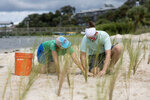

The combination of hurricane season and election season has led to discussions about making coastal communities more “resilient” and it starts with its shorelines.
One way of achieving resiliency is with the creation of living shorelines, which is something contractors and private owners of coastal property are considering more, according to a joint study performed by Florida Sea Grant and the Mississippi-Alabama Sea Grant Consortium.
According to Savanna Barry a Florida Sea Grant regional Extension agent for the Nature Coast, the idea of living coastlines has shifted within the past decade with it seeming to be more of a viable option than was once thought, and her research backs this up.
She recalled a colleague who attempted to introduce the concept during a gathering of marine contractors about a decade ago.
“He was asked to leave,” Barry said. “Late last year, the same organization invited him to come give a talk about living shorelines at their annual conference. So, there is a change in thinking about this.”
In contrast to the use of hardened structures, such as seawalls and bulkheads, living shorelines promote healthy ecosystems and stabilize coasts through the strategic placement of natural materials like native vegetation, rocks and oyster shells to act as natural wave barriers.
Generally, they are also cheaper to install and require less maintenance, which are the primary reasons behind the opinion shift.
“After shorelines are damaged in hurricanes, especially when we see widespread seawall failures but living shorelines usually faring very well; this opens people’s minds to the fact that a nature-based solution may work better than they may have originally expected,” Barry said.
In the study, scientists and Extension agents provided education about living shorelines to contractors through a series of workshops and training, and to property owners through demonstrations, site visits, courses and an informational website.
In Florida, FSG began offering a two-day course for marine contractors in 2019. Since that time, agents have conducted 12 training sessions.
Study evaluations indicated 58% of the 191 participants would “definitely” or “likely” add installation of living shorelines to their services.
To educate property owners, FSG developed a three-day coastal shoreline restoration module for the University of Florida’s Master Naturalist Program.
Instructors taught the course 35 times to 593 participants living in 16 Florida counties. Assessments revealed a 46% knowledge gain about living shorelines, according to the study.
Despite positive strides being made, the study’s authors acknowledge the barriers to living shoreline installation that still exist, due to strict regulatory requirements.
These include rules regarding the height of breakwaters as well as the distance from shore the living shoreline can extend.
“Permitting for living shorelines can sometimes take longer than permitting for a seawall, and for some people that process can be either too daunting or too frustrating,” Barry said. “But state officials are working hard to improve the rules.”